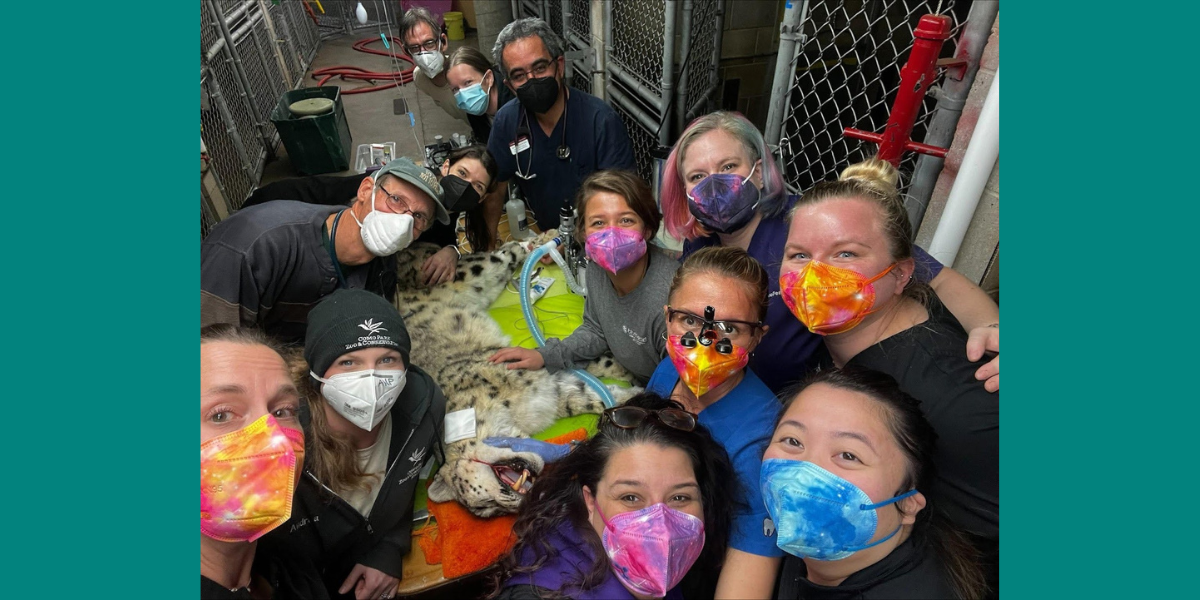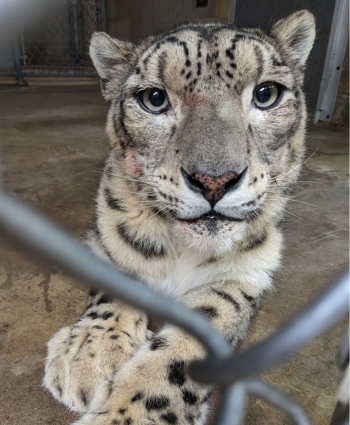Big cat collaboration
When a snow leopard needs teeth pulled, it takes teamwork to get the job done

When a snow leopard needs teeth pulled, it takes teamwork to get the job done
Moutig's care team assembles for a photo. Pictured are Dr. Donnell Hansen, Andrea Persson, Dr. Jim Rasmussen, Dr. Colleen Hickey, Dr. Alonso Guedes, Jill Erzar, Hans Jorgensen, Gracie Pearson, Betsy Stelck, Dr. Emily Edstrom, Lacey Thompson, Jennifer Ficken, and Kelly Yang.
Thirty teeth line the mouth of a snow leopard and make it a deadly trap for anything caught in the cat’s grasp. When Moutig, a 10-year-old snow leopard residing at the Como Park Zoo & Conservatory in St. Paul, recently needed extensive dental work, a team of clinicians put themselves close to those jaws to provide vital care.
Among them were Dr. Alonso Guedes, associate professor of comparative anesthesia and pain medicine at the University of Minnesota College of Veterinary Medicine (CVM), and third-year comparative anesthesia resident Dr. Colleen Hickey. They joined the Como Zoo veterinary team and local veterinary dentists and technicians to perform a tooth extraction procedure on Moutig.
Moutig’s tooth problems were first uncovered during a routine preventative health exam in August 2023. Before the exam, animal care staff had noted a slight decrease in his weight.
To maximize the information obtained during the exam, Dr. Jim Rasmussen, a CVM veterinarian who works closely with the zoo, requested Dr. Emily Edstrom, a veterinary dental specialist from Blue Pearl Pet Hospital, evaluate and X-ray Moutig's teeth. Because of known ocular problems in this species, Dr. Melissa Lively, a veterinary ophthalmologist, was also present to evaluate Moutig's eyes. Fortunately, Moutig's eyes appeared to be without problems. His dental health was a different story.

Images revealed the snow leopard had seven teeth with lesions caused by feline tooth resorption, a condition where the body begins to break down and absorb the enamel of the teeth. The condition likely caused Moutig distress and difficulty eating, leading to his weight loss.
Because of the number of teeth involved, Moutig would require a lengthy procedure under general anesthesia to extract them. His veterinary team brought in Edstrom and fellow veterinary dentist Dr. Donnell Hansen ’05 DVM, along with veterinary technicians from Blue Pearl Pet Hospital to assist with the procedure. To manage the anesthesia, they turned to Guedes and Hickey.
“While many veterinarians have chosen to work exclusively on small or large animals, anesthesia is still multidisciplinary,” Hickey says. “We have experience with patients as small as rodents and as large as giraffes. The resources of a large university like the U of M gives us the freedom to care for many species, which prepares us for the unpredictable.”
Due to the equipment required and the time associated with dental extractions, the team carefully planned out the steps and resources needed as well as each member's roles and responsibilities.`
The anesthesia team weighed the pros and cons of transporting Moutig to the Veterinary Medical Center versus the safety of doing the dental extractions on-site at the zoo. Everyone agreed that the less traveling Moutig required, the better and less stressful the procedure would be for him.
Planning for a case outside the University veterinary hospital meant the anesthesia team needed to anticipate any possible complications and the tools and equipment required should problems arise. They also had to consider pain management for Moutig following the procedure.

“This is always a tough consideration for zoo species because we can’t give them injectable medications after big procedures due to their temperament,” Hickey says. “Fortunately for Moutig, he received a few local nerve blocks with a long-acting local anesthetic—like a person would receive at the dentist.”
Preparing for Moutig’s procedure required the dentistry team to anticipate every potential care need and outcome. The team transferred everything from oral surgery instruments to root canal therapy equipment from the hospital to the zoo enclosure where the procedure would occur—moving two truckloads of equipment in advance. Adapting small animal dental equipment to meet the unique needs and anatomy of a larger carnivore like Moutig required creativity and trips to the hardware store.
The dentists also considered the best outcome for each affected tooth.
“Every tooth is a patient, and teeth are not intended to be extracted—especially in the large cats—these are huge teeth, which are important to their function,” Edstrom says. “However, painful and infected teeth need care, so we must weigh the pros and cons of each individual procedure for each individual tooth.”
In Moutig’s case, to avoid additional sedation later, Edstrom and Hansen planned to work simultaneously to efficiently extract teeth in hopes of providing the most comfortable outcome for the leopard.
On Nov. 6, 2023, Moutig’s care team assembled, and the procedure began.
The dentists first removed six cheek teeth and concluded with the large, firmly rooted canine—the most challenging to remove. As the dental team extracted Moutig’s teeth, Guedes and Hickey monitored him closely. Many large cats develop a sudden increase in potassium levels in the blood during surgery, which can lead to cardiac arrest and other heart problems.

Prepared for just such an event, Guedes and Hickey carefully watched Moutig’s blood potassium and intervened when levels suddenly increased toward the end of his procedure. The team’s rapid response averted possible cardiac arrest.
Fortunately, because the anesthesia team kept Moutig stable during the procedure, the dental team successfully extracted all seven affected teeth. In all, the procedure took about 2.5 hours. Moutig’s case exemplifies the positive impact that results from the collaboration of veterinary professionals across specialties and organizations.
Moutig recovered quickly from his procedure, resumed his routine—albeit without rabbits or bones in his diet—and is back to drawing crowds at the zoo with his graceful movements and big personality.